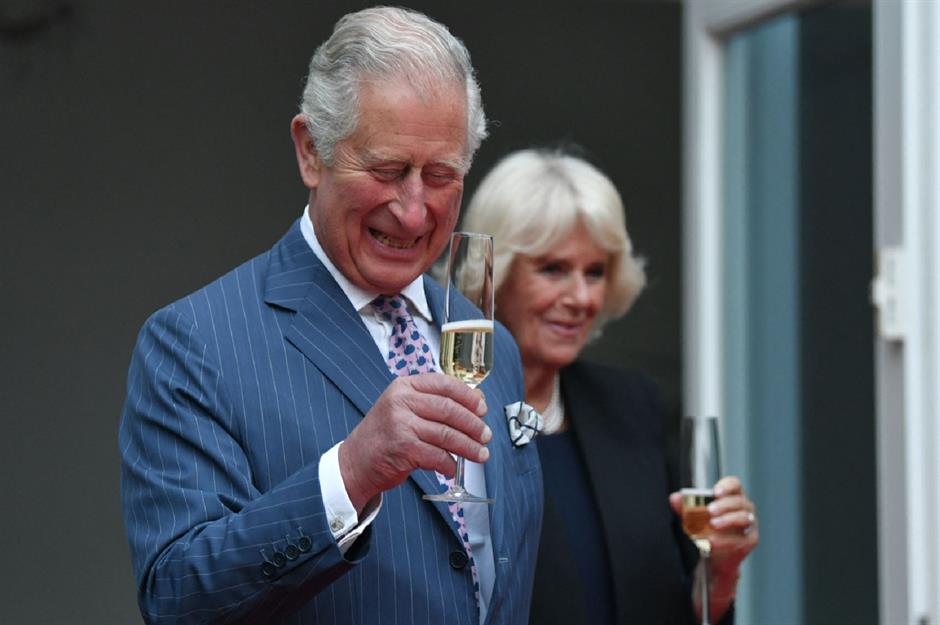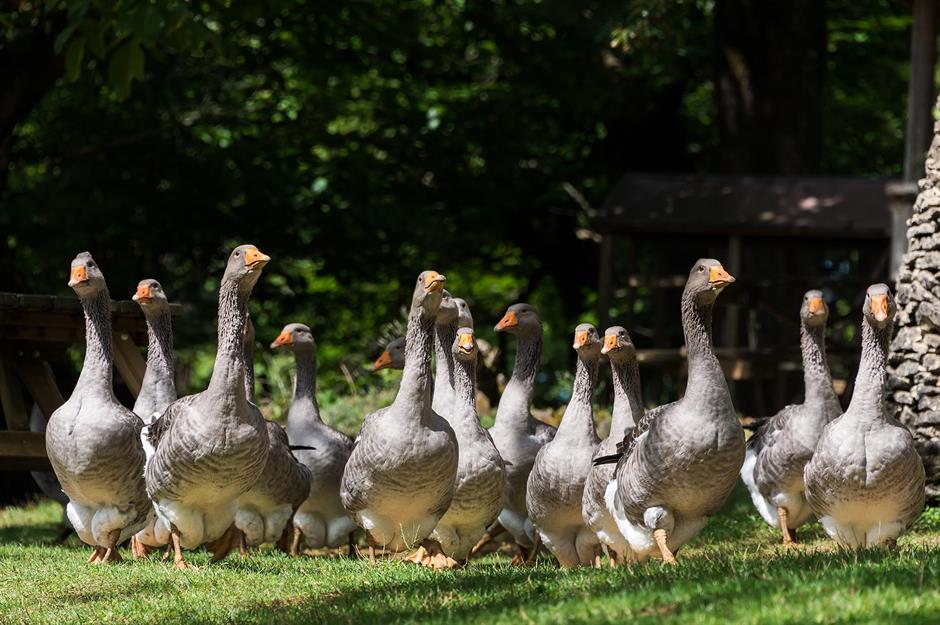Food and drink King Charles and the royals won't touch
No royal seal of approval
This weekend we'll all be raising a glass to King Charles as we celebrate his Majesty's coronation – but while we're sure the royals will also mark the occasion with a bottle of fizz or two, there's a long list of food and drink that they'd never dream of indulging in. Whether it’s due to protocol, personal preference or avoiding food poisoning, these are the foods you'll never find on a royal menu.
Foie gras
Given King Charles’ passion for animal welfare and organic farming, it comes as no surprise that this controversial goose liver pâté has no place in the royal kitchens. Due to concerns over the luxury food's cruel production process, foie gras is illegal in the UK. In 2008, the then–Prince Charles banned it from being served in all royal residences.
Seafood
The royals tend to avoid eating seafood and shellfish due to potential food poisoning concerns, but that’s not to say that they don’t break the rules occasionally. Prince William has revealed that he's a huge fan of sushi – and on a recent trip to the Bahamas, Kate Middleton was seen bravely sampling local delicacy conch pistol (male sea snail’s genitalia).
Potatoes, rice and pasta
According to former royal chef Darren McGrady, the late Queen Elizabeth II avoided eating carbs. Instead, she preferred fish or game with roasted vegetables for dinner, plus some fruit for pudding. The late Queen only indulged in potatoes, rice and pasta during state banquets, or on special occasions.
Pizza
The former royal chef also revealed that the late Queen didn't eat pizza – or at least, she never did during the 15 years he cooked for her. (Pizza is, however, a favourite of Princes William and Harry.) Burgers were a different story, but not the cheesy kind most of us know and love; her late Majesty liked her patties with no bun, and served with cranberry sauce.
Tempted to try a burger yourself? Try one of our 30 delicious recipes
Anything you eat with your hands
The no-bun burger makes sense, given the late Queen's reluctance to eat carbs – but the dish was probably also influenced by Victorian etiquette, which dictates that there's only one food that can be eaten with the hands: afternoon tea. According to these old-fashioned rules, all other foods must be eaten using cutlery, including burgers – and even bananas. Apparently, the late Queen peeled and sliced them with a knife and fork.
Garlic
During an appearance on MasterChef Australia, Camilla, the then–Duchess of Cornwall, revealed that garlic is another no-go for members of the royal family – apparently, having garlic breath is unacceptable when in polite company. Former royal chef Darren McGrady confirmed this, saying that the late Queen disliked the pungent ingredient, and would never have it on the menu.
Wrong-temperature biscuits
As we all know, Brits take their biscuits very seriously – and King Charles is no different. It’s been said that the King will only eat biscuits that have been warmed to an exact temperature. A connoisseur of cookies, he founded the brand Duchy Originals, known for its oaty biscuits, in 1990.
Meat and gluten
Meghan, the Duchess of Sussex, is known to adhere to a plant-based diet during the week, while also avoiding gluten. However, she does indulge in meat on weekends, and has often been referred to as a part-time vegan. She and Prince Harry are said to be fond of roast chicken; in fact, it's the dish Harry cooked Meghan before proposing to her.
Non-organic foods
Once called 'Britain's best known organic farmer' by The Guardian, King Charles champions organic food, and takes immense pride in his environmentally conscious eating habits. The King has even been known to take his organic food with him on tours overseas. His food brand, Duchy Originals, merged with Waitrose in 2010, becoming Waitrose Duchy Organics – and the company now sells organic food all over the UK.
Wasteful dishes
The royals are staunchly against food waste and, just like us commoners, they reuse their leftovers. Former royal chef Carolyn Robb has talked about how staff in the royal kitchens are required to cook small portions to avoid food waste, and to incorporate any leftovers into the next day’s meal. The late Queen was also known for being fond of using Tupperware.
Raw or rare meat
No steak tartare for the royals! The royal family tend to stay away from foods that are more likely to cause food poisoning, including raw meat; cooking it well is one of the best ways to eliminate bacteria. To every chef’s dismay, the late Queen Elizabeth II apparently liked her steaks and Sunday roasts well-done.
Sandwiches with crusts
The late Queen Elizabeth II didn't tend to indulge in many extravagant foods, but there was one notable exception: afternoon tea. She enjoyed this quintessentially British tradition every day, with everything served to the highest standard. Crusts on sandwiches were a real no-no; in fact, they were practically banned.
A history of afternoon tea: why we love it, and how to host your own
Non-bottled water
The royals are known to drink only British bottled water, whether they're travelling around the world on official trips or staying at home. The water they drink is supplied by companies awarded a Royal Warrant, such as Hildon water.
Oysters
Oysters are another delicacy that's avoided by the royals due to the risk of food poisoning – and it's well known that the late Queen Elizabeth II and Prince Philip disliked them too. Royal footman Charles Oliver confirmed this in his book, Dinner at Buckingham Palace. Commonly eaten raw and with the hands, oysters break several of the late Queen's food rules.
Unfamiliar foods
The royals are advised to stay away from foods that may give them a stomach upset, or that they may dislike, to avoid inadvertently offending their hosts. There have, of course, been exceptions to this rule – but nevertheless, the palace always briefs its hosts on these conditions to avoid any potential issues. The BBC reported years ago that the late Queen avoided any food that was 'too spicy or exotic' during her travels.
Onions
Just like garlic, onions are rarely used in royal kitchens to avoid smelly breath. With many recipes using onion as a base for flavour, this is a tricky one to adhere to. Apparently, onions are used in small quantities in the palace kitchens, but never in a way that they can be tasted – and they're certainly never served raw.
Spicy foods
Nothing would make the news faster than a picture of His Royal Highness running for a glass of milk after eating a hot curry. If you’re not used to having spicy food, it could easily upset your stomach, which is something the royals try to avoid. Prince William has also revealed that he’s no good at handling spice, saying: "I'm not a vindaloo man, put it that way". However, the Princess of Wales is known to be fond of spicy curries.
Swan
Swan used to be a delicacy at banquets and feasts, which, in hindsight, probably helped to cause a decline in the waterbird's population. Of course, it’s now illegal to eat them. However, ancient law decrees that all swans in the UK belong to the King, so King Charles is technically exempt from this rule. If, in theory, he wished to dine on a swan, he could – but it’s highly unlikely that he would.
Marshmallows
Prince Harry has revealed that he has never toasted a marshmallow, as he finds them too sweet. Perhaps he's more into savoury treats – as a child he loved McDonald’s, where Princess Diana used to take him and Prince William.
White eggs
The late Queen Elizabeth II prefered brown eggs over white, according to The Guardian. The colour of eggs is determined by the breed of hen that lays them, whereas the flavour has more to do with the hen's environment and diet. Brown eggs tend to be more expensive because of the quality of the food the hens are given.
Hard-boiled eggs
King Charles is also particular when it comes to eggs; his breakfast egg must be boiled for exactly four minutes to guarantee a perfectly runny yolk. It has been claimed that the King's cooks prepare seven eggs for him each morning, of which he eats only one, but his Majesty has debunked this myth as he despises food waste. Instead, chefs have devised ways to cook the King's eggs with exacting precision – which may involve security personnel radioing the kitchen with his ETA!
Out-of-season fruit
Former royal chef Darren McGrady has revealed that the late Queen was insistent that all fruit and vegetables served from the royal kitchens should be in season, as part of the royal family's sustainable approach to eating. Staff have also confirmed that the palace is very economical in the way it's run; for example, mushrooms foraged from the royal estate are frozen to make them last longer.
Tomato sauce
During a trip to Italy, it was reported that the late Queen requested a tomato sauce–free menu (if you’ve ever eaten tomato pasta while wearing a white shirt, you’ll understand). With garlic and pasta being off the menu too, we’re sure the Italian chefs had to get creative!
Lunch
King Charles has a habit of skipping lunch, eating only twice a day, with a late breakfast and a hefty dinner. This allows for longer working hours, particularly when on tour, and keeps him on track with his diet, which he is very conscious of. His long-serving staff know to pack snacks for themselves, as they don't get a lunch break.
Peppers
In an interview with You magazine about her favourite foods, Queen Consort Camilla revealed that she "can't bear peppers, raw or cooked". She also confirmed that she avoids chilli, and that she isn't a fan of offal.
Chocolate
The late Queen may have been partial to a chocolatey dessert, but according to former royal kitchen manager Graham Tinsley MBE, King Charles doesn't like chocolate at all. The royal chefs make sure they consider all of the King's food likes and dislikes when creating menus for him.
Coffee (after 4pm)
The Duchess of Sussex doesn't drink coffee after 4pm. She said: "It's easy to fall into the trap of rushing for a coffee when you hit that 4pm slump. But if I blend some apple, kale, spinach, lemon and ginger in my Vitamix in the morning, I always find that sipping on that is a much better boost than a cup of espresso."

